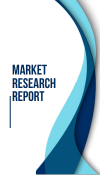
Global Cell Culture Plasticware Market "(By Product Type: Cell Culture Dishes, Cell Culture Flask, Cell Culture Plate, Cell Culture Tube, Other Accessories; By Material Type: Polystyrene, Polypropylene, Polycarbonate, Coated Surfaces, Biodegradable Plastics; By Application: Biopharmaceutical Production, Tissue Engineering, Cell Therapy, Drug Development and Testing, Basic Research; By End-User Industry: Academic Research Institutions, Pharmaceutical and Biotechnology Companies, Contract Research Organizations (CROs), Clinical Laboratories, Others; By Sterilization Type: Gamma Sterilization, Ethylene Oxide Sterilization, Steam Sterilization, Radiation Sterilization, Non-Sterile Products; By Region: North America, Europe, Asia Pacific, Latin America, and Middle East and Africa)”- Global Industry Analysis, Size, Share, Growth, Trends, And Forecast, 2024-2032
- Category: Pharmaceuticals and Biotechnology
- Report ID: CMR34455
- Published Date:
A prominent research firm, Cognizance Market Research, added a cutting-edge industry report on the “Global Cell Culture Plasticware Market”. The report studies the current and past growth trends and opportunities for the market to gain valuable insights during the forecast period from 2023 to 2032.
Global Cell Culture Plasticware Market Analysis:
According to cognizance market research, the global Cell Culture Plasticware market was valued at US$ 4.84 billion in 2023 and is anticipated to reach US$ 8.93 billion by the end of 2032 with a CAGR of 7% from 2023 to 2032.

What is the Global Cell Culture Plasticware Market?
The worldwide market for cell culture plasticware consists of laboratories that produce and disseminate plastic laboratory tools designed to cultivate cells under laboratory test conditions. The essential tools used for academic research drug discovery vaccine production and biopharmaceutical manufacturing consist of these plasticware items including culture flasks dishes multiwell plates and pipettes and tubes.
Significant market growth occurred because investors increased their funding of cell-based research activities, along with developing personalized medicine and regenerative therapies, and expanding their production of biologics. The essential requirements of research facilities include cell growth environments that are reliable and sterile, and chemically stable, along with high-quality plasticware that provides these requirements. Cell adhesion and proliferation function best when utilizing treated polystyrene to produce most of these products.
The market demand, along with innovation, stems from North America and Europe since these regions support robust research facilities and host market leaders such as Thermo Fisher Scientific, Corning Inc., and BD Biosciences. Present-day Asia-Pacific shows signs of quick market expansion because governments give higher funding to healthcare research and development, and because biotechnology industries continue growth and production costs decline in countries such as China and India.
The market expansion derives from expanding scientific use in stem cell studies, as well as cancer research and vaccine creation, and drug evaluation work. The global cell culture plasticware market will continue to grow because of improved plastic materials alongside surface treatments, which receive support from rising demands for scalable and cost-effective cell culture solutions in academic laboratories and pharmaceutical sectors, and clinical facilities.
Global Cell Culture Plasticware Market Outlook:
The global market for cell culture plasticware will experience gradual expansion in future years due to growing scientific research activities in regenerative medicine, together with biologics production and personalized medicine fields. Plasticware demand for drug development and toxicity testing applications grows due to the rising use of cell-based assays.
Market participants are active in innovation through the development of improved surface treatments and specialized coatings, including collagen and fibronectin, and the development of appropriate formats for both 3D cell culture and high-throughput screening purposes. The market shows growing demand for automation-based plasticware options with compatibility for live-cell imaging systems, which enables advanced research capabilities.
The market leadership presently rests with North America and Europe, yet the Asia-Pacific area shows rapid growth because of mounting government support and biotechnology investments, together with rising clinical trial activities. Companies operate new production sites as well as distribute products across developing markets to make their products cheaper and easier to reach.
The biopharmaceutical market expansion and academic boost of cell biology research spending drive increasing demand for flasks, plates and dishes, and other consumable materials. Members of the contract research and manufacturing organization industry (CROs and CDMOs) are driving up worldwide plasticware consumption levels.
While promising, the market must overcome main obstacles, including the waste management implications of disposable plasticware and material cost fluctuations. Business opportunities exist to advance biodegradable materials and sustainable manufacturing practices, which may revolutionize the market’s anticipated trajectory.
Segment Analysis:
Market segments of cell culture plasticware on a global level exist for product type, applications and end-user groups. Culture dishes and flasks together with plates and pipettes as well as tubes and other plasticware components form the main segments of this market. Supplied formats of multiwell plates and flasks dominate industrial and academic research because they enable high-throughput screenings and scale, depending on research settings. Surface-treated and coated plasticware variants are becoming more popular because they offer better cell adhesion properties when used in stem cell and cancer research applications.

Within the various applications the market supports, there are biopharmaceutical production and drug discovery and tissue engineering, and stem cell research, together with clinical diagnostics applications. The biopharmaceutical industry maintains the highest market share because it supports the increasing production of both vaccines and biologic pharmaceuticals. The market’s end-user domain consists of pharmaceutical & biotech companies alongside research institutes and contract research organizations (CROs), where CROs demonstrate swift expansion because of increasing outsourcing activities. Plasticware demonstrates high utility and essential function due to its diverse compatibility with research environments and commercial operations in various domains.




Geographical Analysis:
The North American market leads in global market share because it benefits from a robust biomedical research infrastructure and its developed biopharmaceutical sector, and major companies such as Thermo Fisher Scientific, Corning, and BD Biosciences. The United States ranks first because it commits significant resources to research and development, while the NIH funds experiments and medical organizations that extensively employ cell cultures for drug development and tissue engineering applications.
The global cell culture industry places Europe as its second-largest market segment, where Germany, together with the UK and France, serves as a major contributor. The area has a sturdy academic research infrastructure, together with extensive widespread usage of advanced cell culture approaches across public and private sector facilities. EU safety standards promote high-quality laboratory consumables to specifications that favor premium plasticware providers.
Asia-Pacific stands out as the most rapidly developing region because China, India, South Korea, and their respective governments continue to make healthcare investments in parallel with their expanding biotechnology industries through institutional backing. Both local producers and international corporations are building new production capabilities to keep pace with the rising demand in that area. These emerging markets including Latin America and the Middle East & Africa have been adopting advanced cell culture tools because of improving research infrastructure and pharmaceutical industry growth.

The report offers the revenue of the Global Cell Culture Plasticware Market for the period 2020-2032, considering 2020 to 2022 as a historical year, 2023 as the base year, and 2024 to 2032 as the forecast year. The report also provides the compound annual growth rate (CAGR) for the global Cell Culture Plasticware market for the forecast period. The global Cell Culture Plasticware market report provides insights and in-depth analysis into developments impacting enterprises and businesses on a regional and global level. The report covers the global Cell Culture Plasticware market performance in terms of revenue contribution from several segments and comprises a detailed analysis of key drivers, trends, restraints, and opportunities prompting revenue growth of the global Cell Culture Plasticware market.
The report has been prepared after wide-ranging secondary and primary research. Secondary research included internet sources, numerical data from government organizations, trade associations, and websites. Analysts have also employed an amalgamation of bottom-up and top-down approaches to study numerous phenomena in the global Cell Culture Plasticware market. Secondary research involved a detailed analysis of significant players’ product portfolios. Literature reviews, press releases, annual reports, white papers, and relevant documents have also been studied to understand the Global Cell Culture Plasticware Market. Primary research involved a great extent of research efforts, wherein experts carried out interviews telephonic as well as questionnaire-based, with industry experts and opinion-makers.
The report includes an executive summary, along with a growth pattern of different segments included in the scope of the study. The Y-o-Y analysis with elaborate market insights has been provided in the report to comprehend the Y-o-Y trends in the global Cell Culture Plasticware market. Additionally, the report focuses on altering competitive dynamics in the global market. These indices serve as valuable tools for present market players as well as for companies interested in participating in the global Cell Culture Plasticware market. The subsequent section of the global Cell Culture Plasticware market report highlights the USPs, which include key industry events (product launch, research partnership, acquisition, etc.), technology advancements, pipeline analysis, prevalence data, and regulatory scenarios.
Global Cell Culture Plasticware Market Competitive Landscape:
There are several small and major firms participating in the highly fragmented global Cell Culture Plasticware market. The new strategies formed by companies revolve around accuracy and precision. The following are some of the major market participants:
- Thermo Fisher
- Corning
- Greiner Bio-One
- MilliporeSigma
- Sumitomo Bakelite
- Lonza, Taurus Inc.
- captivate Bio
- SPL Life Science
- BD Bioscience
- JJBiotek
- Haridas and Company
- Labiostring
- Thistle Scientific
- Allele Life Science.
The report explores the competitive scenario of the Global Cell Culture Plasticware Market. Major players working in the Global Cell Culture Plasticware Market have been named and profiled for unique commercial attributes. Company overview (company description, product portfolio, geographic presence, employee strength, Key management, etc.), financials, SWOT analysis, recent developments, and key strategies are some of the features of companies profiled in the Global Cell Culture Plasticware Market report.
Segmentation:
Global Cell Culture Plasticware Market, By Product Type:
- Cell Culture Dishes
- Cell Culture Flask
- Cell Culture Plate
- Cell Culture Tube
- Other Accessories
Global Cell Culture Plasticware Market, By Material Types:
- Polystyrene
- Polypropylene
- Polycarbonate
- Coated Surfaces
- Biodegradable Plastics
Global Cell Culture Plasticware Market, By Application:
- Biopharmaceutical Production
- Tissue Engineering
- Cell Therapy
- Drug Development and Testing
- Basic Research
Global Cell Culture Plasticware Market, By Application:
- Academic Research Institutions
- Pharmaceutical and Biotechnology Companies
- Contract Research Organizations (CROs)
- Clinical Laboratories
- Others
Global Cell Culture Plasticware Market, By Sterilization:
- Gamma Sterilization
- Ethylene Oxide Sterilization
- Steam Sterilization
- Radiation Sterilization
- Non-Sterile Products
Global Cell Culture Plasticware Market, by Region:
- North America
- U.S.
- Canada
- Europe
- Germany
- U.K.
- France
- Spain
- Italy
- Rest of Europe
- Asia Pacific
- Japan
- China
- India
- Australia & New Zealand
- South Korea
- Rest of Asia Pacific
- Latin America
- Brazil
- Mexico
- Rest of Latin America
- Middle East & Africa
- GCC
- South Africa
- Rest of the Middle East & Africa
Research Methodology: Aspects
Market research is a crucial tool for organizations aiming to navigate the dynamic landscape of customer preferences, business trends, and competitive landscapes. At Cognizance Market Research, acknowledging the importance of robust research methodologies is vital to delivering actionable insights to our clientele. The significance of such methodologies lies in their capability to offer clarity in complexity, guiding strategic management with realistic evidence rather than speculation. Our clientele seek insights that excel superficial observations, reaching deep into the details of consumer behaviours, market dynamics, and evolving opportunities. These insights serve as the basis upon which businesses craft tailored approaches, optimize product offerings, and gain a competitive edge in an ever-growing marketplace.
The frequency of information updates is a cornerstone of our commitment to providing timely, relevant, and accurate insights. Cognizance Market Research adheres to a rigorous schedule of data collection, analysis, and distribution to ensure that our reports reflect the most current market realities. This proactive approach enables our clients to stay ahead of the curve, capitalize on emerging trends, and mitigate risks associated with outdated information.
Our research process is characterized by meticulous attention to detail and methodological rigor. It begins with a comprehensive understanding of client objectives, industry dynamics, and research scope. Leveraging a combination of primary and secondary research methodologies, we gather data from diverse sources including surveys, interviews, industry reports, and proprietary databases. Rigorous data analysis techniques are then employed to derive meaningful insights, identify patterns, and uncover actionable recommendations. Throughout the process, we remain vigilant in upholding the highest standards of data integrity, ensuring that our findings are robust, reliable, and actionable.
Key phases involved in in our research process are mentioned below:

Understanding Clients’ Objectives:
Extensive Discussions and Consultations:
- We initiate in-depth discussions and consultations with our clients to gain a comprehensive understanding of their objectives. This involves actively listening to their needs, concerns, and aspirations regarding the research project.
- Through these interactions, we aim to uncover the underlying motivations driving their research requirements and the specific outcomes they hope to achieve.
Industry and Market Segment Analysis:
- We invest time and effort in comprehensively understanding our clients’ industry and market segment. This involves conducting thorough research into market trends, competitive dynamics, regulatory frameworks, and emerging opportunities or threats.
- By acquiring a deep understanding of the broader industry landscape, we can provide context-rich insights that resonate with our clients’ strategic objectives.
Target Audience Understanding:
- We analyze our clients’ target audience demographics, behaviors, preferences, and needs to align our research efforts with their consumer-centric objectives. This entails segmenting the audience based on various criteria such as age, gender, income level, geographic location, and psychographic factors.
- By understanding the nuances of the target audience, we can tailor our research methodologies to gather relevant data that illuminates consumer perceptions, attitudes, and purchase intent.
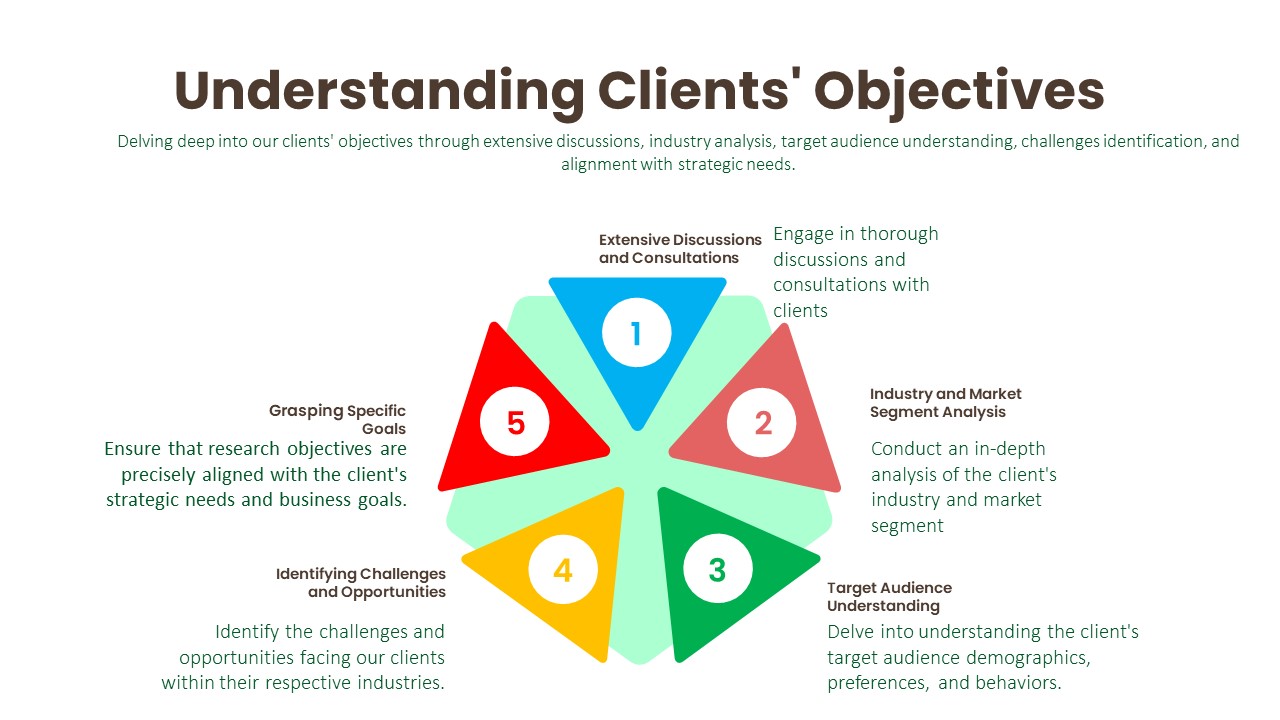
Identifying Challenges and Opportunities:
- We proactively identify the challenges and opportunities facing our clients within their respective industries. This involves conducting SWOT (Strengths, Weaknesses, Opportunities, Threats) analyses and competitive benchmarking exercises.
- By identifying potential obstacles and growth drivers, we can provide strategic recommendations that help our clients navigate complexities and capitalize on emerging opportunities effectively.
Grasping Specific Goals:
- We delve into the intricacies of our clients’ objectives to gain clarity on the specific goals they aim to accomplish through the research. This entails understanding their desired outcomes, such as market expansion, product development, or competitive analysis.
- By gaining a nuanced understanding of our clients’ goals, we can tailor our research approach to address their unique challenges and opportunities effectively.
Data Collection:
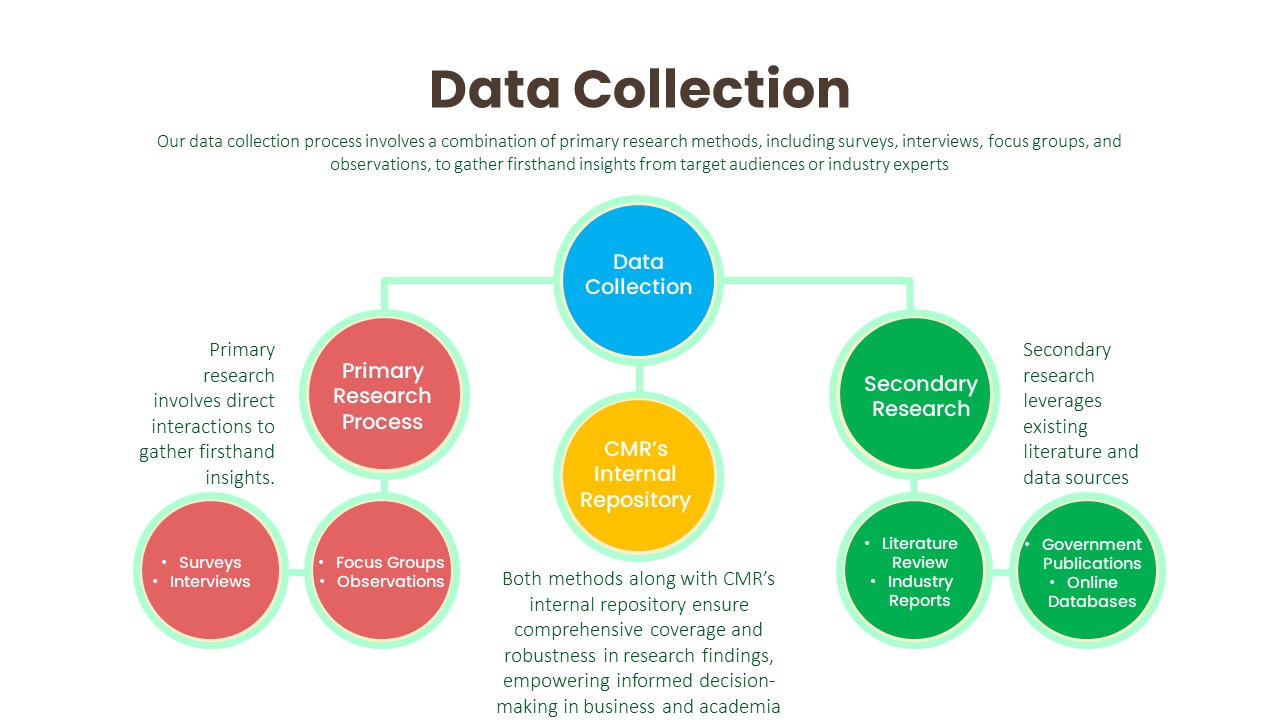
Primary Research Process:
- Surveys: We design and administer surveys tailored to capture specific information relevant to our clients’ objectives. This may involve employing various survey methodologies, such as online, telephone, or face-to-face interviews, to reach target audiences effectively.
- Interviews: We conduct structured or semi-structured interviews with key stakeholders, industry experts, or target consumers to gather in-depth insights and perspectives on relevant topics. These interviews allow us to probe deeper into specific issues and uncover valuable qualitative data.
- Focus Groups: We organize focus group discussions with carefully selected participants to facilitate interactive discussions and gather collective opinions, attitudes, and preferences. This qualitative research method provides rich contextual insights into consumer behaviors and perceptions.
- Observations: We conduct observational research by directly observing consumer behaviors, interactions, and experiences in real-world settings. This method enables us to gather objective data on consumer actions and reactions without relying on self-reported information.
Secondary Research Process:
- Literature Review: We conduct comprehensive literature reviews to identify existing studies, academic articles, and industry reports relevant to the research topic. This helps us gain insights into previous research findings, theoretical frameworks, and best practices.
- Industry Reports: We analyze industry reports published by reputable trade associations (whitepapers, research studies, etc.), and government agencies (U.S. Census Bureau, Bureau of Labor Statistics, and Securities and Exchange Commission etc.) to obtain macro-level insights into market trends, competitive landscapes, and industry dynamics.
- Government Publications: We review government publications, such as economic reports, regulatory documents, and statistical databases, to gather relevant data on demographics, market size, consumer spending patterns, and regulatory frameworks.
- Online Databases: We leverage online databases, such as industry portals, and academic repositories (PubMed Central (PMC), ScienceDirect, SSRN (Social Science Research Network), Directory of Open Access Journals (DOAJ), NCBI, etc.), to access a wide range of secondary data sources, including market statistics, financial data, and industry analyses.
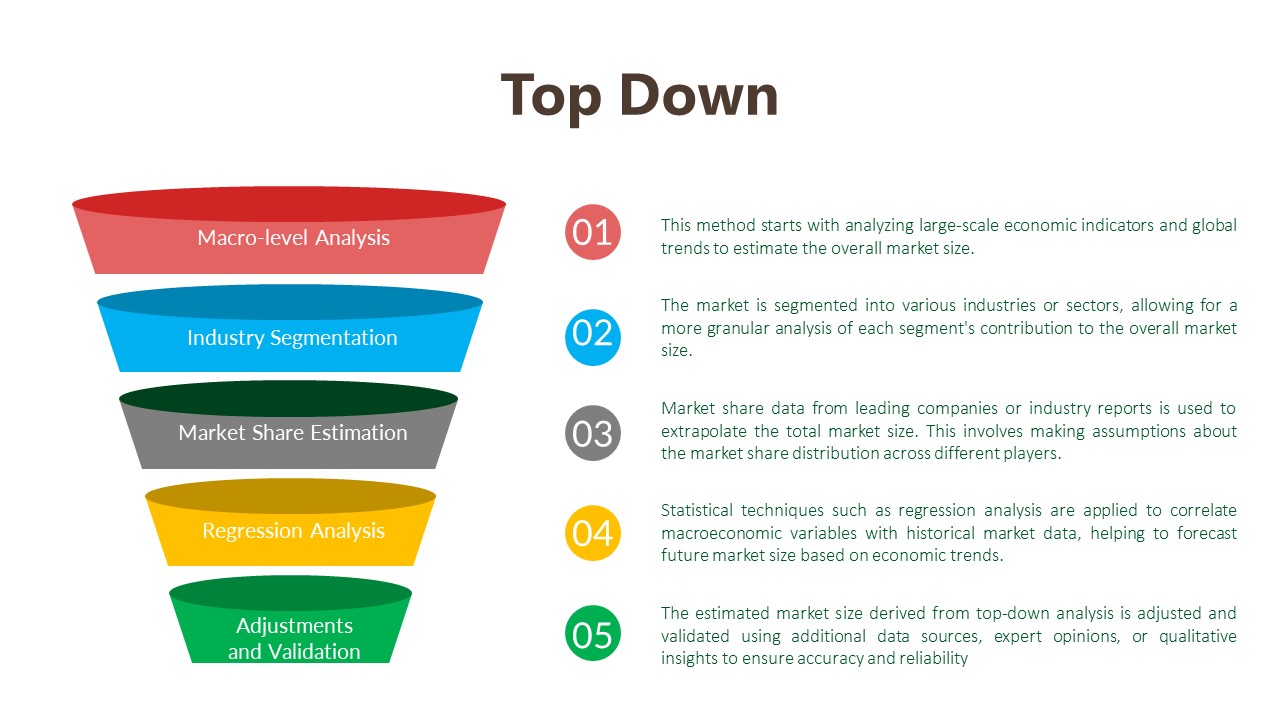
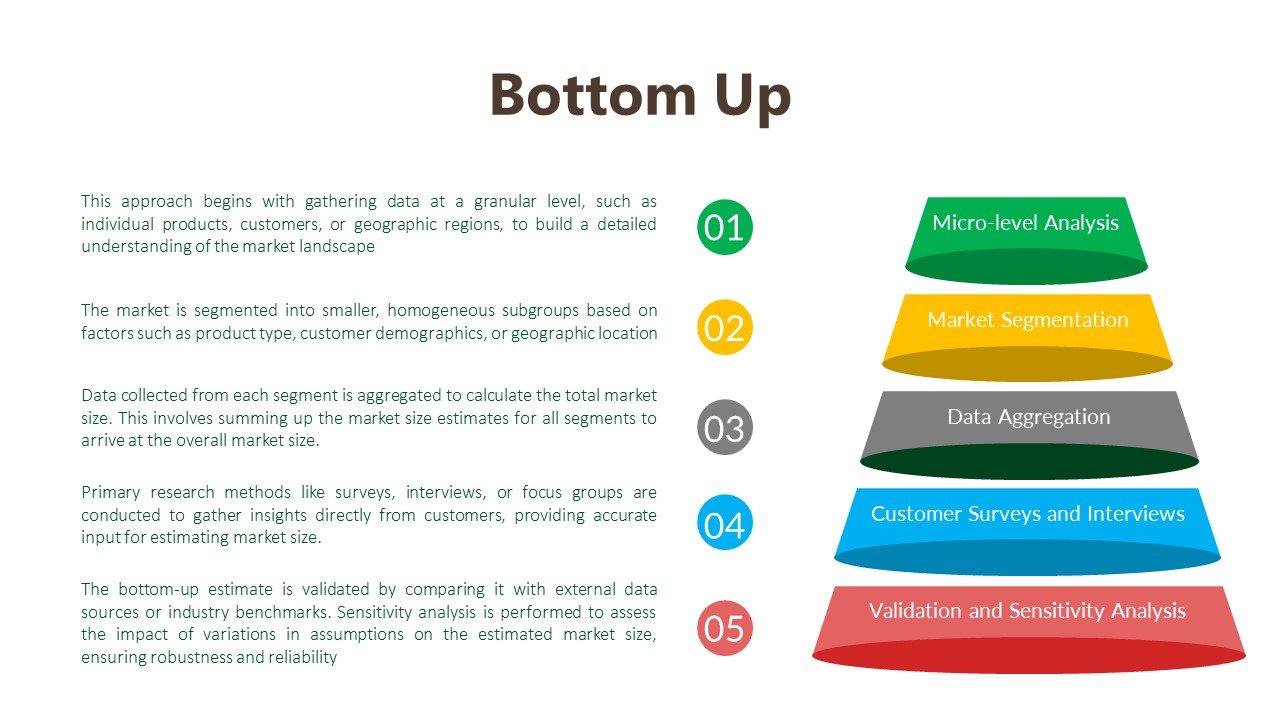
Data Analysis:
The data analysis phase serves as a critical juncture where raw data is transformed into actionable insights that inform strategic decision-making. Through the utilization of analytical methods such as statistical analysis and qualitative techniques like thematic coding, we uncover patterns, correlations, and trends within the data. By ensuring the integrity and validity of our findings, we strive to provide clients with accurate and reliable insights that accurately reflect the realities of the market landscape.

Transformation of Raw Data:
- Upon collecting the necessary data, we transition into the data analysis phase, where raw data is processed and transformed into actionable insights. This involves organizing, cleaning, and structuring the data to prepare it for analysis.
Utilization of Analytical Methods:
- Depending on the research objectives, we employ a diverse range of analytical methods to extract meaningful insights from the data. These methods include statistical analysis, trend analysis, regression analysis, and qualitative coding.
Statistical Analysis:
- Statistical tools are instrumental in uncovering patterns, correlations, and trends within the data. By applying statistical techniques such as descriptive statistics, hypothesis testing, and multivariate analysis, we can discern relationships and derive valuable insights.
Qualitative Analysis Techniques:
- In addition to quantitative analysis, we leverage qualitative analysis techniques to gain deeper insights from qualitative data sources such as interviews or open-ended survey responses. One such technique is thematic coding, which involves systematically categorizing and interpreting themes or patterns within qualitative data.
Integrity and Validity Maintenance:
- Throughout the analysis process, we maintain a steadfast commitment to upholding the integrity and validity of our findings. This entails rigorous adherence to established methodologies, transparency in data handling, and thorough validation of analytical outcomes.
Data Validation:
The final phase of our research methodology is data validation, which is essential for ensuring the reliability and credibility of our findings. Validation involves scrutinizing the collected data to identify any inconsistencies, errors, or biases that may have crept in during the research process. We employ various validation techniques, including cross-referencing data from multiple sources, conducting validity checks on survey instruments, and seeking feedback from independent experts or peer reviewers. Additionally, we leverage internal quality assurance protocols to verify the accuracy and integrity of our analysis. By subjecting our findings to rigorous validation procedures, we instill confidence in our clients that the insights they receive are robust, reliable, and trustworthy.
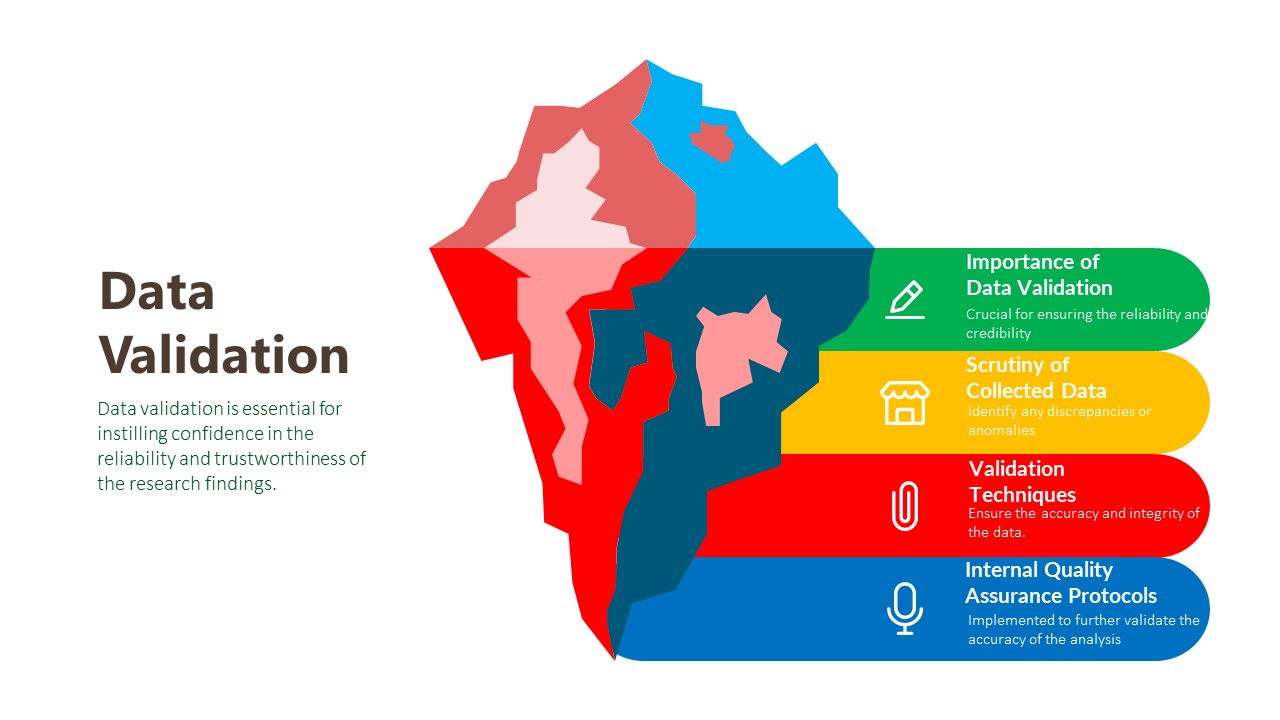
Importance of Data Validation:
- Data validation is the final phase of the research methodology, crucial for ensuring the reliability and credibility of the findings. It involves a systematic process of reviewing and verifying the collected data to detect any inconsistencies, errors, or biases.
Scrutiny of Collected Data:
- The validation process begins with a thorough scrutiny of the collected data to identify any discrepancies or anomalies. This entails comparing data points, checking for outliers, and verifying the accuracy of data entries against the original sources.
Validation Techniques:
- Various validation techniques are employed to ensure the accuracy and integrity of the data. These include cross-referencing data from multiple sources to corroborate findings, conducting validity checks on survey instruments to assess the reliability of responses, and seeking feedback from independent experts or peer reviewers to validate the interpretation of results.
Internal Quality Assurance Protocols:
- In addition to external validation measures, internal quality assurance protocols are implemented to further validate the accuracy of the analysis. This may involve conducting internal audits, peer reviews, or data validation checks to ensure that the research process adheres to established standards and guidelines.
Report Scope:
Attribute
Description
Market Size
US$ 8.93 billion (2032)
Compound Annual Growth Rate (CAGR)
7.00%
Base Year
2023
Forecast Period
2024-2032
Forecast Units
Value (US$ Billion)
Report Coverage
Revenue Forecast, Competitive Landscape, Growth Factors, and Trends
Geographies Covered
North America, Europe, Asia Pacific, Latin America, Middle East & Africa
Countries Covered
U.S., Canada, Germany, U.K., France, Spain, Italy, Rest of Europe, Japan, China, India, Australia & New Zealand, South Korea, Rest of Asia Pacific, Brazil, Mexico, Rest of Latin America, GCC, South Africa, Rest of Middle East & Africa
Key Companies Profiled
Thermo Fisher, Corning, Greiner Bio-One, MilliporeSigma, Sumitomo Bakelite, Lonza, Taurus Inc., captivate Bio, SPL Life Science, BD Bioscience, JJBiotek, D. Haridas and Company, Labiostring, Thistle Scientific, and Allele Life Science.
Key Questions Answered in Cell Culture Plasticware Market Report
How big was the global Cell Culture Plasticware market in 2023?
It was valued at US$ 4.84 billion in 2023.
How big will the industry size in 2032?
It is projected to reach more than US$ 8.93 billion by 2032.
What will be the CAGR during the forecast period?
It is anticipated to be 7% from 2024 to 2032.
What are the trends, drivers, opportunities, and challenges in the global Cell Culture Plasticware market?
Trend: The adoption of advanced 3D cell culture plasticware formats that also integrate automation capabilities directs future research procedures.
Driver: The growth of the cell culture plasticware market expands because people are increasingly demanding biologics, cell-based assay and regenerative medicine application.
Opportunities: The opportunity to develop sustainable biodegradable plasticware stands out as highly important during times of growing environmental concern.
Challenges: Single-use plastics, along with varying raw material prices, create sustainability-based issues and market costs for manufacturers.
What are the major players operating in the global Cell Culture Plasticware market?
Thermo Fisher, Corning, Greiner Bio-One, MilliporeSigma, Sumitomo Bakelite, Lonza, Taurus Inc., captivate Bio, SPL Life Science, BD Bioscience, JJBiotek, D. Haridas and Company, Labiostring, Thistle Scientific, and Allele Life Science.
We can customize every report – free of charge – including purchasing stand-alone sections or country-level reports
We help clients to procure the report or sections of the report at their budgeted price. Kindly click on the below to avail



